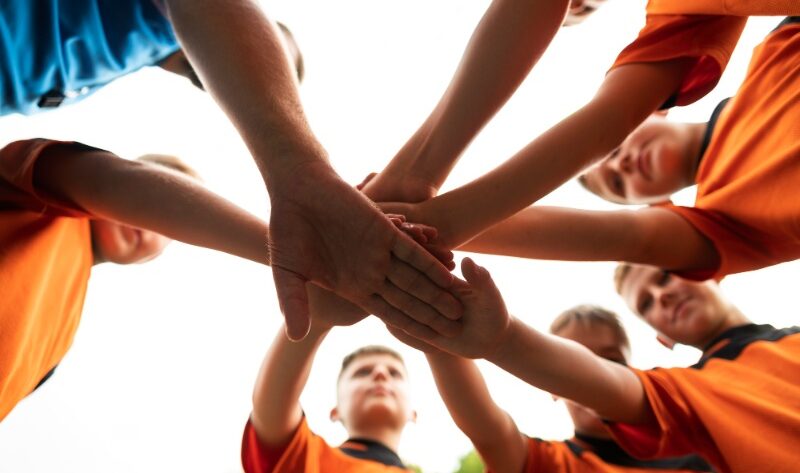Sports have long been considered an integral part of society, not only for their physical benefits but also for their ability to foster social connections, personal growth, and community cohesion. In a world where individuals are often consumed by their personal routines and digital lives, sports provide an opportunity to engage with others, build relationships, and create a shared sense of purpose and pride. In this article, we will explore the ways in which sports help build stronger communities, the underlying principles that contribute to this process, and how organizations, local governments, and individuals can harness the power of sports to make lasting positive impacts on their communities.
The Role of Sports in Building Community
Sports have a unique ability to transcend social, cultural, and economic boundaries. They bring people from all walks of life together to achieve a common goal, whether it’s winning a game, improving individual performance, or simply enjoying a shared activity. Here are some of the key ways that sports can help build stronger communities:
1. Promoting Social Cohesion
One of the most powerful ways in which sports contribute to community building is by promoting social cohesion. When people participate in sports, they often join teams, clubs, or organizations that emphasize collaboration, mutual support, and working together toward a shared goal. This process of working as a team encourages social interaction and strengthens bonds between individuals who might otherwise not have interacted.
For example, community sports leagues provide an environment where individuals can connect with neighbors, make new friends, and build relationships based on common interests. These social interactions can help reduce feelings of isolation and build a sense of belonging.
2. Bridging Cultural Divides
Sports have the ability to unite people from diverse backgrounds. Whether it’s a local soccer match or an international competition, sports offer a platform where cultural differences can be celebrated rather than dividing people. By bringing together individuals from various ethnic, socioeconomic, and cultural groups, sports promote understanding and tolerance.
In many communities, sports teams are microcosms of the larger society. They provide an environment where people from different walks of life can work together, interact, and form lasting friendships. This inclusivity helps break down cultural barriers, creating a more harmonious and unified community.
3. Fostering Volunteerism and Civic Engagement
Sports also play a crucial role in fostering volunteerism and civic engagement. Many community sports programs rely on volunteers to coach, organize events, and provide administrative support. This sense of volunteerism instills a spirit of giving back and encourages individuals to take active roles in their communities.
Furthermore, sports events often serve as fundraisers or charitable events that support various causes. These events mobilize the community, encouraging people to contribute their time, resources, and energy for the betterment of others. Whether it’s a local charity run, a youth sports camp, or a benefit match, sports provide a platform for individuals to give back to their communities.
4. Supporting Youth Development
Participation in sports is particularly beneficial for young people. By engaging in team sports, children and adolescents can develop important life skills such as teamwork, leadership, discipline, and time management. These skills are not only valuable on the playing field but also help young people navigate their academic, social, and professional lives.
Additionally, sports provide a healthy outlet for physical activity, helping to combat rising rates of childhood obesity and other health issues. Beyond physical health, sports help instill confidence, resilience, and a sense of achievement, giving young people the tools they need to succeed in life.
5. Encouraging Community Pride and Identity
Sports have the ability to unite entire communities under a common banner. Whether it’s supporting a local high school team, a regional sports club, or a national sports franchise, fans and participants alike take pride in their teams’ accomplishments. This collective support fosters a sense of community identity, which can lead to greater community involvement and pride.
For example, a local team that wins a championship can serve as a symbol of the community’s spirit and resilience. The shared joy and pride in these victories can enhance the overall sense of unity within the community, creating a positive feedback loop that encourages further participation and support.
6. Promoting Physical and Mental Health
Sports contribute to community well-being not only by fostering social connections but also by promoting physical and mental health. Regular participation in physical activities such as running, soccer, or basketball helps reduce the risk of chronic diseases, improves cardiovascular health, and boosts overall fitness.
On the mental health front, sports are known to reduce stress, anxiety, and depression. Engaging in physical activity releases endorphins, which are natural mood enhancers. Sports also provide an opportunity for individuals to take their minds off daily stressors and focus on something positive and enjoyable. Communities that prioritize sports and physical activity tend to have higher levels of overall well-being, contributing to a healthier, happier population.
7. Creating Economic Opportunities
A thriving sports culture can also bring economic benefits to a community. Local sporting events, tournaments, and leagues can attract visitors, boost local businesses, and create job opportunities. Small businesses, such as restaurants, stores, and hotels, benefit from the influx of people attending sports events. Additionally, sports facilities and programs generate employment opportunities in coaching, event planning, and facility management.
By supporting local sports teams and events, communities can drive economic growth while simultaneously fostering a sense of pride and connection. Economic growth resulting from sports can further improve the infrastructure and services available to residents, creating a positive cycle of improvement.
How to Foster a Community Spirit Through Sports
While sports have inherent community-building potential, it requires intentional effort to create and nurture these connections. Here are some strategies that individuals, organizations, and local governments can implement to use sports as a tool for community development:
1. Encourage Inclusivity and Accessibility
To build a strong community through sports, it’s essential to make sports accessible to people from all backgrounds, regardless of age, ability, or income. Offering a variety of sports programs, from recreational leagues to competitive teams, and ensuring that they are affordable and open to all can help foster inclusivity. Creating adaptive sports programs for individuals with disabilities also promotes community integration and equality.
2. Promote Volunteer Opportunities
Encouraging local residents to get involved in volunteering for sports programs helps strengthen the sense of community ownership. Volunteer coaches, referees, and event organizers are essential to running successful sports programs. By involving residents in the decision-making process, communities can cultivate a greater sense of pride and responsibility toward local sports initiatives.
3. Invest in Facilities and Infrastructure
Well-maintained sports facilities are crucial for creating a thriving sports culture. Local governments and organizations can work together to build or renovate community sports complexes, parks, and recreational areas to make them more accessible. By investing in the physical infrastructure for sports, communities make a long-term commitment to supporting active, healthy lifestyles.
4. Host Community Sports Events
Organizing community sports events, such as charity runs, sports festivals, and local competitions, can help bring people together and foster a sense of collective identity. These events create opportunities for residents to connect, cheer for their local teams, and celebrate their community’s achievements. They can also raise awareness about important causes and generate funds for local initiatives.
FAQs
1. How can sports help improve a community’s health?
Sports promote physical activity, reducing the risk of obesity, heart disease, and other health conditions. They also enhance mental health by lowering stress and anxiety levels, fostering a sense of well-being.
2. What are some examples of how sports have united different cultures?
Global sporting events like the Olympics and the FIFA World Cup bring together people from diverse cultures. Local events, such as multicultural sports festivals, can also promote cultural exchange and understanding.
3. How can sports contribute to youth development?
Sports teach children teamwork, leadership, discipline, and time management, providing valuable life skills that extend beyond the playing field. Youth sports also offer a positive outlet for energy and help foster social connections.
4. Can sports reduce crime in communities?
Yes, sports provide structured activities for young people, keeping them engaged and away from negative influences. By offering positive outlets for energy, sports can reduce youth involvement in criminal behavior.
5. How do sports foster community pride?
When a local team succeeds, it brings the community together to celebrate their collective achievement. This shared pride enhances a sense of belonging and identity within the community.
6. How can sports programs promote volunteerism?
Sports programs often rely on volunteers for coaching, event planning, and support roles. Encouraging residents to get involved in these programs strengthens community ties and fosters a spirit of giving.
7. What role do sports events play in local economies?
Sports events can bring visitors to the area, boosting local businesses like restaurants, hotels, and stores. They also create jobs and generate economic activity, benefiting the entire community.
Conclusion
Sports are a powerful tool for building stronger, more connected communities. Through their ability to foster social cohesion, promote inclusivity, support youth development, and enhance physical and mental well-being, sports create environments where individuals can grow, bond, and thrive together. By prioritizing sports in community development initiatives and ensuring accessibility for all, we can create more unified and resilient communities that work together to achieve common goals.
Key Takeaways
- Sports promote social cohesion by bringing together individuals from diverse backgrounds, fostering collaboration, and strengthening bonds within communities.
- Sports bridge cultural divides and create opportunities for individuals to celebrate differences while working toward shared goals.
- Youth development is enhanced through sports, which teach life skills such as teamwork, leadership, and discipline.
- Physical and mental health are improved through regular participation in sports, helping to reduce stress, anxiety, and physical health risks.
- Community pride and identity are strengthened when individuals come together to support local sports teams and events, creating a sense of belonging.
- Economic benefits of sports include job creation, increased local business activity, and improved infrastructure, contributing to community growth.




